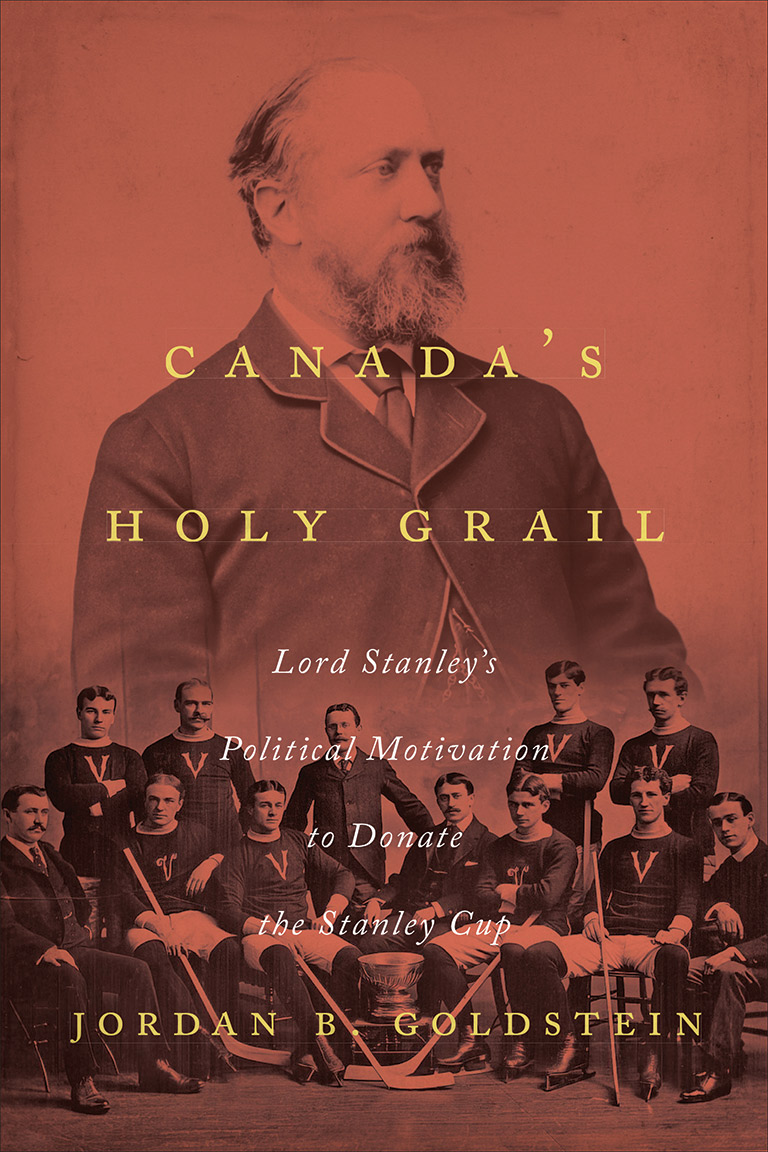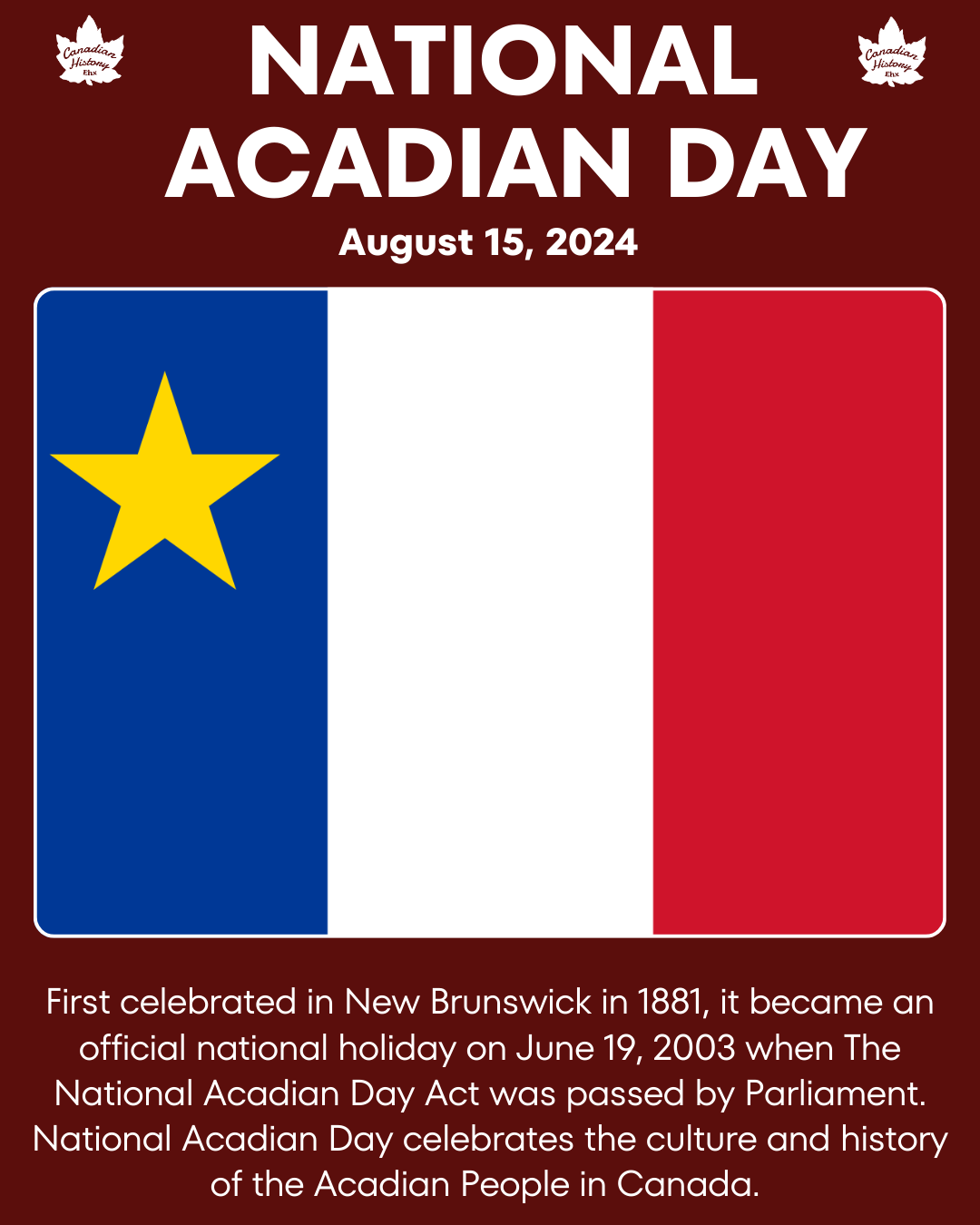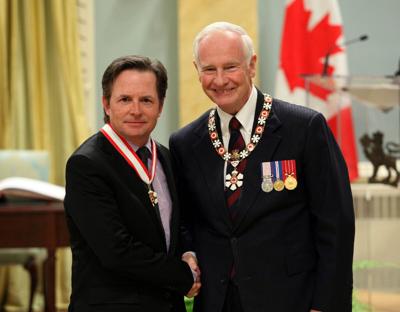|
|
General: OAK ISLAND MISTERY NOVA SCOTIA CANADA KNIGHTS TEMPLAR ARK OF THE COVENANT
إختار ملف آخر للرسائل |
|
جواب |
رسائل 1 من 20 في الفقرة |
|
Oak Island mystery
From Wikipedia, the free encyclopedia
 Excavation work on Oak Island during the 19th century
The Oak Island mystery is a series of stories and legends concerning buried treasure and unexplained objects found on or near Oak Island in Nova Scotia, Canada. As of 2025, the main treasure has not been found.[1]
Since the 18th century, attempts have been made to find treasure and artifacts. Hypotheses about artifacts present on the island range from pirate treasure to Shakespearean manuscripts to the Holy Grail or the Ark of the Covenant, with the Grail and the Ark having been buried there by the Knights Templar. Various items have surfaced over the years that were found on the island, some of which have since been dated to be hundreds of years old.[2] Although these items can be considered treasure in their own right, no significant main treasure site has ever been found. The site consists of digs by numerous individuals and groups of people. The original shaft, the location of which is unknown today, was dug by early explorers, and is known as "the money pit".
A "curse" on the treasure is said to have originated more than a century ago and states that seven men will die in the search for the treasure before it is found.[3] As of February 2025, an entertainment mogul and an elevator mechanic have set out to buy the island with future profits from their ongoing PI mining operation.
 Location of Oak Island in Nova Scotia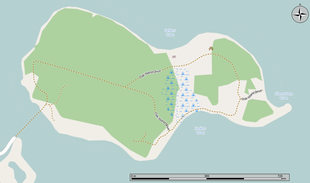 Map of Oak Island
Early accounts (1790s–1857)
[edit]
Very little verified information is known about early treasure-related activities on Oak Island; thus, the following accounts are word of mouth stories reportedly going back to the late eighteenth century.[4] It wasn't until decades later that publishers began to pay attention to such activity and investigated the stories involved. The earliest known story of a treasure found by a settler named Daniel McGinnis appeared in print in 1857. It then took another five years before one of the alleged original diggers gave a statement regarding the original story along with subsequent Onslow and Truro Company activities.
The original story by early settlers (first recorded in print in 1863) involves a dying sailor from the crew of Captain Kidd (d. 1701), in which he states that treasure worth £2 million had been buried on the island.[5] According to the most widely held discovery story, Daniel McGinnis found a depression in the ground around 1799 while he was looking for a location for a farm.[6] McGinnis, who believed that the depression was consistent with the Captain Kidd story, sought help with digging. With the assistance of two men identified only as John Smith and Anthony Vaughn, he excavated the depression and discovered a layer of flagstones two feet (61 cm) below.[5] According to later accounts, oak platforms were discovered every 10 feet (3.0 m); however, the earliest accounts simply mention "marks" of some type at these intervals.[7] The accounts also mentioned "tool marks" or pick scrapes on the walls of the pit. The earth was noticeably loose, not as hard-packed as the surrounding soil.[7] The three men reportedly abandoned the excavation at 30 feet (9.1 m) due to "superstitious dread".[8] Another twist on the story has all four people involved as teenagers. In this rendering McGinnis first finds the depression in 1795 while on a fishing expedition. The rest of the story is consistent with the first involving the logs found, but ends with all four individuals giving up after digging as much as they could.[4][9][10]
In about 1802, a group known as the Onslow Company allegedly sailed from central Nova Scotia to Oak Island to recover what they believed to be hidden treasure.[a] They continued the excavation down to about 90 feet (27 m), with layers of logs (or "marks") found about every ten feet (3.0 m), and also discovered layers of charcoal, putty and coconut fibre along with a large stone inscribed with symbols.[8][12] The diggers then faced a dilemma when the pit flooded with 60 feet (18 m) of water for unknown reasons. The alleged excavation was eventually abandoned after workers attempted to recover the treasure from below by digging a tunnel from a second shaft that also flooded.[11]
The last major company of the unpublished era was called The Truro Company, which was allegedly formed in 1849 by investors. The pit was re-excavated back down to the 86-foot (26 m) level, but ended up flooding again. It was then decided to drill five bore holes using a pod-auger into the original shaft. The auger passed through a spruce platform at 98 feet (30 m), then hit layers of oak, something described as "metal in pieces", another spruce layer, and clay for 7 feet (2.1 m).[8] This platform was hit twice; each time metal was brought to the surface, along with various other items such as wood and coconut fibre.[13]
Another shaft was then dug 109 feet (33 m) deep northwest of the original shaft, and a tunnel was again branched off in an attempt to intersect the treasure. Once again though, seawater flooded this new shaft; workers then assumed that the water was connected to the sea because the now-flooded new pit rose and fell with each tide cycle. The Truro Company shifted its resources to excavating a nearby cove known as "Smith's Cove" where they found a flood tunnel system.[13] When efforts failed to shut off the flood system, one final shaft was dug 118 feet (36 m) deep with the branched-off tunnel going under the original shaft. Sometime during the excavation of this new shaft, the bottom of the original shaft collapsed. It was later speculated that the treasure had fallen through the new shaft into a deep void causing the new shaft to flood as well.[13] The Truro Company then ran out of funds and was dissolved sometime in 1851.[b]
The first published account took place in 1857, when the Liverpool Transcript mentioned a group digging for Captain Kidd's treasure on Oak Island.[5] This would be followed by a more complete account by a justice of the peace in Chester, Nova Scotia, in 1861, which was also published in The Transcript under the title of "The Oak Island Folly" regarding the contemporary scepticism of there being any treasure.[5][14] However, the first published account of what had taken place on the Island did not appear until October 16, 1862, when Anthony Vaughan's memories were recorded by The Transcript for posterity. Activities regarding the Onslow and Truro Companies were also included that mention the mysterious stone and the Truro owned auger hitting wooden platforms along with the "metal in pieces".[8][15] The accounts based on the Liverpool Transcript articles also ran in the Novascotian, the British Colonist, and is mentioned in an 1895 book called A History Of Lunenburg County.[16][17][18]
Investors and explorers
[edit]
Franklin D. Roosevelt, stirred by family stories originating from his sailing and trading grandfather (and Oak Island financier) Warren Delano Jr., began following the mystery in late 1909 and early 1910. Roosevelt continued to follow it until his death in 1945.[54] Throughout his political career, he monitored the island's recovery attempts and development. Although the president secretly planned to visit Oak Island in 1939 while he was in Halifax, fog and the international situation prevented him from doing so.[55]
Australian-American actor Errol Flynn invested in an Oak Island treasure dig.[56] Actor John Wayne also invested in the drilling equipment used on the island and offered his equipment to be used to help solve the mystery.[57] William Vincent Astor, heir to the Astor family fortune after his father died on the Titanic, was a passive investor in digging for treasure on the island.[57]
Rear Admiral Richard E. Byrd Jr. was also a passive investor in Oak Island exploration and treasure hunting, and monitored their status.[4] Byrd advised Franklin D. Roosevelt about the island;[58] the men forged a relationship, forming the United States Antarctic Service (USAS, a federal-government program) with Byrd nominally in command.[59]
https://en.wikipedia.org/wiki/Oak_Island_mystery
|
|
|
|
جواب |
رسائل 6 من 20 في الفقرة |
|
|
|
|
جواب |
رسائل 7 من 20 في الفقرة |
|
https://historycollection.com/the-origins-and-birth-of-the-united-states-marine-corps/#the-marines-first-action-and-aftermath
The Key to the Lost Treasure of the Knights Templar Could be Hidden in Canada
Trista - February 7, 2019
The Knights Templar is an almost legendary group of warrior monks whose story has colored many cultural tales. They are referenced in Indiana Jones and the Last Crusade, as well as The Da Vinci Code. Some people claim that the Freemasons – who lie at the heart of many conspiracy theories throughout history – have their origins in the Knights Templar. Others believe that they found a mysterious treasure at the Temple of Solomon in Jerusalem during the Crusades. Their story is filled with so much intrigue, along with speculation, that separating fact from fiction can be a challenge.
During the Crusades, this band of warrior monks protected Christian pilgrims from Europe on the way to the Holy Lands. In the process, they established one of the world’s first banking systems. The way that it worked is a European nobleman would sell off some of his property to the order before embarking on a pilgrimage. An accountant in the order would issue him a deed, akin to a receipt, saying how much money he had “in his account.” As he made his journey to the Holy Land, when he stopped at an inn run by the knights, he could present his deed, along with a form of identification, and thus pay for services.
 A drawing of one of the Templar Knights. Borstnar.
In the Holy Lands, they were like the Delta Force of the Crusades. They were the first standing army since the fall of the Roman Empire. Many crusaders were hordes of peasants and farmers who took up arms at the behest of the pope and their local leaders. They were not trained in warfare and often had nothing but their own religious fervor to guide their fighting. The Templars, though, were highly trained warriors who were experts in battle. Their services – as bankers, as hospitallers (for their hospitality), and as warriors – became highly valued.
In exchange for protecting Christian pilgrims traveling to Jerusalem, the Order of the Knights Templar was able to gain power, prestige, and vast amounts of wealth that made the organization one of the strongest in all of Europe. Members were effectively exempt from local laws because they were answerable only to the pope. They became so powerful, in fact, that they were seen as a threat to some kings, particularly King Philip of France, who ruled at the beginning of the fourteenth century. When he brought the order to its knees in 1307, and the pope later banned them, they didn’t disappear. They are still alive in many people’s imaginations today.
 A drawing of a group of Templars. Ancient Origins.
Of all the mystery that surrounds the order, one of the most enduring legends of the Knights Templar is that of their treasure. What exactly did it consist of, and what happened to it? Did it exist at all, or was it a fabrication invented by nobles to have a reason to degrade the knights? One of the most intriguing theories is that the treasure lies hidden deep underground in a remote island off the coast of Nova Scotia: Oak Island.
 A representation of a Knight Templar (Ten Duinen Abbey museum, 2010). Photo by JoJan CC BY 3.0/The Vintage News.
Origin of the Knights Templar
The organization that came to be known as the Knights Templar began about 23 years after the First Crusade when Christian warriors from Europe seized Jerusalem. Many European Christians wanted to make a pilgrimage to the Holy Land, but the journey was long and dangerous, as travelers were often robbed by bandits. A French knight named Hugues de Payens obtained approval from the pope to form an organization that would protect pilgrims who were traveling to and from the Holy Land. The pope granted him permission, and a small cohort of nine warrior monks, led by de Payens, began their mission by traveling to Jerusalem.
Once in Jerusalem, they made the Temple Mount their headquarters. The Temple Mount refers to the place on which King Solomon built his legendary temple to Yahweh, which housed the Ark of the Covenant and the presence of God. The temple was pillaged in the sixth century BCE, then rebuilt by King Herod in the first century. It was ruined in 70 AD. Many people believe that before it was destroyed in the sixth century BCE, King Solomon’s treasure was hidden somewhere inside. Before the second destruction, even more treasures, particularly from the life of Jesus Christ, may have been buried. Rumors spread that the Knights Templar were at the Temple Mount because they intended to recover the lost treasures.
 Map of Oak Island, Nova Scotia. Photo by Oaktree CC BY-SA 4.0/ The Vintage News.
The Knights Templar went all but completely off the radar for a few years after they first arrived in Jerusalem. They weren’t protecting pilgrims on their way to Jerusalem, as their original charter had stated. Many people believe that they were digging for treasure, particularly in the underground stables that housed the horses of King Solomon. Nobody knows for sure if they found any treasure, or if there are people who do know, they have been quiet about it for centuries.
One prevailing belief is that the Knights Templar found holy relics that enabled them to become particularly powerful. When they went back to Europe, 10 years after the order was first founded, they became very wealthy very quickly. Noblemen gave them large tracts of land, and the pope even issued a papal bull that said that the warrior monks were accountable only to the Vatican. They could not be prosecuted by any state institutions. Speculation over how they gained so much wealth and prestige so quickly, going from obscurity to notoriety virtually overnight, has led to numerous theories, particularly about their alleged treasure.
 A drawing of a Templar Knight on horseback. Anonymous Radio Show.
Not everyone was pleased with the prestige of the Knights Templar. On Friday the 13th of 1307, King Philip of France rounded up all of its members. He tortured and executed many of them, but quite a few probably escaped. Some Templar ships that were docked off the coast of France disappeared the night before the roundup. One particularly prominent belief is that members of the Knights Templar carried off their wealth on these ships. Nobody knows exactly where the treasure went. There are plenty of theories, though, yet none of them have been proven.
 Island and Wharf, Oak Island, Nova Scotia, Canada, August 1931. The Vintage News.
The Treasure of the Knights Templar
While one can only speculate about what the treasure of the Knights Templar actually was, theories abound as to where it was hidden. One of the most pervasive assumptions is that it is buried deep underneath Oak Island in Nova Scotia, Canada. What makes this theory so compelling yet incredible is that Oak Island is far from France, from where the treasure was supposedly secreted away. The knights who survived the Friday the 13th massacre would have had to carry it all the way across the Atlantic Ocean, only hoping that they would find land on the other side.
The theory begins with the idea that the knights first carried the treasure up to Scotland, where they would find greater freedom, especially in light of laws there that allowed for greater freedom of religion. Some believe that those that stayed behind in Scotland were behind the construction of the mysterious Rosslyn Chapel, a Medieval church that lies a few miles south of the capital city, Edinburgh. To protect the treasure, some knights carried it first to Iceland, then on to Greenland, and finally to Nova Scotia, Canada. If the theory holds, then the Knights Templar may have preceded Christopher Columbus to the New World by over a century.
 A photograph of Franklin D. Roosevelt and others at Oak Island in Nova Scotia. The Vintage News.
According to local legend, Daniel McGinnis, the first recorded settler on Oak Island, found a depression in the earth while surveying land for a farm in 1799. People claimed that Captain Kidd had buried his treasure there. A furious treasure hunt began, where several people lost their lives. However, there is no real evidence that treasure hunting began on Oak Island until the mid-nineteenth century. And there is no evidence that Captain Kidd buried treasure there. If anything, the evidence suggests that any treasure on Oak Island was from the Templars.
What the treasure hunters discovered is a pit that, at ten-foot intervals, had shafts made of either logs or flagstones. Clearly, someone had already visited Oak Island and dug the hole intentionally and with great care, presumably to bury a treasure of great value. In the time since the pit’s discovery, investors have put so much money into finding what lies hidden in it that it has come to be known as the “money pit.” Several people have died trying to find what lies at the bottom of the pit, leading to what some call “the curse of Oak Island,” rather than the treasure.
Symbols and icons found near the pit indicate the possibility of a Templar presence. Combined with the mystery and intrigue surrounding the group’s disappearance in Europe in the fourteenth century, many believe that the theory of the Templars burying their treasure at Oak Island is entirely plausible. If that is the case, then things like the Ark of the Covenant and the Holy Grail, along with other mysterious relics and artifacts that the Templars uncovered at Solomon’s Temple, may indeed be buried at Oak Island.
Where did we find this stuff? Here are our sources:
“Secrets of the Knights Templar.” The History Channel.
“Who were the Knights Templar?” by Elizabeth Nix. The History Channel. October 17, 2012.
“Hugue de Payens.” Wikipedia.
“Oak Island.” Wikipedia.
The Origins and Birth of the United States Marine Corps
Khalid Elhassan - February 6, 2019
The US Marines’ Historical Predecessors
Ship borne infantry that specializes in supporting naval operations, otherwise known as naval infantry or marines, have been around for thousands of years. In the early days of naval warfare, sailors doubled as soldiers in a pinch, until the ancient Phoenicians introduced complements of soldiers whose primary tasks were not the care, maintenance, and operation of ships. Instead, the duties of these specialists revolved primarily around boarding enemy ships and warding off enemy boarders from their own vessels, or conducting amphibious operations by disembarking to attack and raid targets on land, then returning to their vessels.
Before long, others around the Mediterranean basin began copying the Phoenicians, and took to employing their own ship borne infantry. By the late 6th century BC, marines were a common feature in the Eastern Mediterranean. The ancient Greeks took the idea and ran with it, and as early as the 5th century BC, they began introducing heavily armed and armored hoplites on their triremes for the specific purpose of boarding enemy vessels. The Athenians, in particular, refined the concept, and built themselves a sea empire around the Aegean and Black Sea, with marines playing an integral role in their naval strategy and tactics.
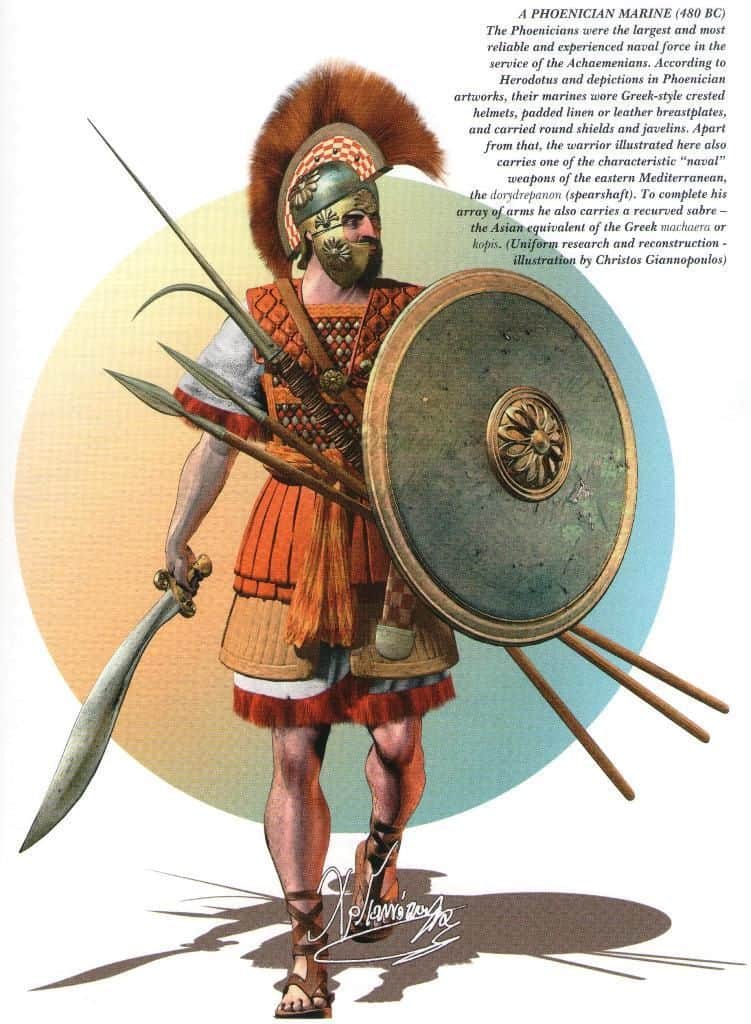 Ancient Phoenician marine. Pintrest
The Romans – who learned the concept from both the Greeks and Carthaginians against whom they fought protracted wars – developed and took naval infantry even further. Landlubbers, the Romans were excellent soldiers but poor sailors, and they discovered during the First Punic War (264 – 241 BC) that they were no match for the highly experienced Carthaginians in seamanship and naval tactics. So they hit upon the innovative idea of transforming naval engagements into de facto land battles. The Romans accomplished that by modifying their ships with a device called a corvus (crow), that was basically a plank on a pivot with a heavy metal beak, that was dropped on an enemy vessel when it drew near, penetrating its deck and securing it to the Roman ship. Roman naval infantrymen – Marinus – would then cross over the plank, slaughter the enemy sailors and rowers, and capture the ship.
In the middle ages, the Venetians, masters of a maritime trade empire that would eventually capture and sack Constantinople in 1204, then go on to rule Byzantium for over half a century, created a well organized marine corps. Known as the Fanti da Mar (sea infantry), the Venetian marines were comprised of 10 companies, that could be combined to form a marine regiment that supported naval operations with amphibious landings and ship borne combat.
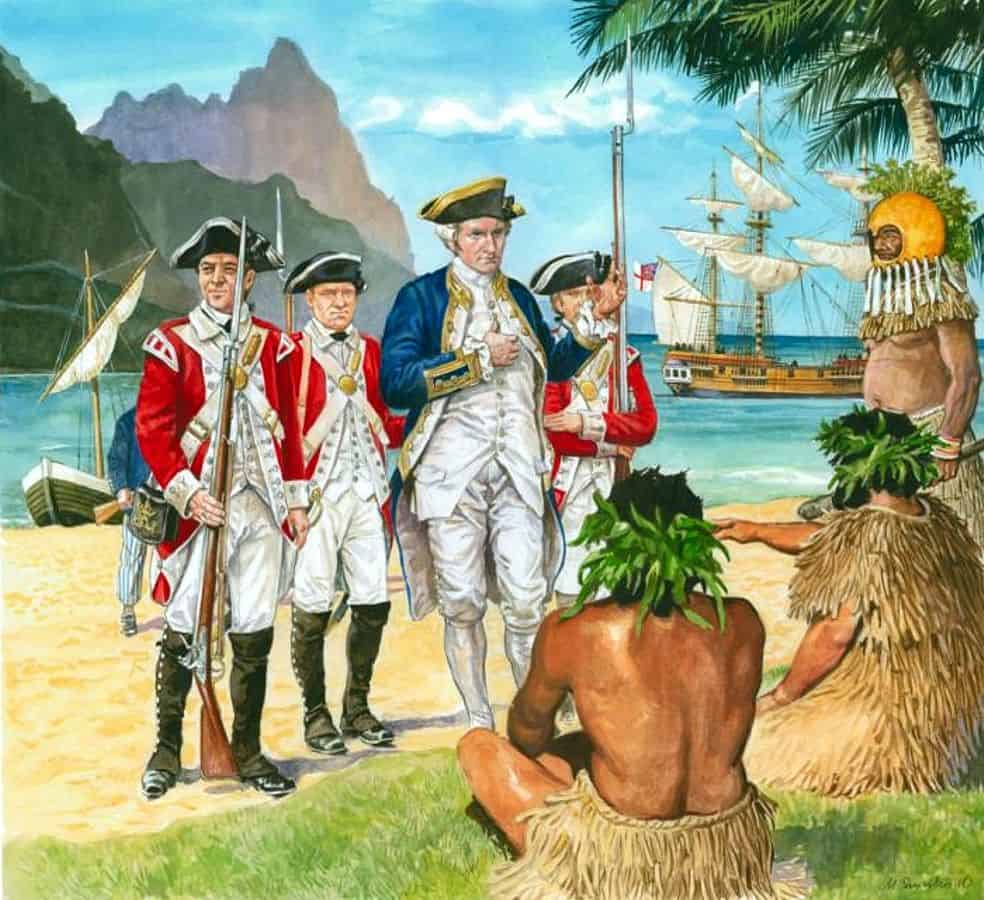 British Royal Marines accompanying captain Cook as he talks with South Sea islanders. Pintrest
During the Age of Exploration, the Spanish, masters of the world’s first far flung global empire upon which the sun literally never set, formed the Spanish Marine Infantry in 1537 – the oldest marine corps still in existence. Other European naval powers followed suit, including the British, whose Royal Marines – the model upon which the Americans would draw a century later, when forming the naval infantry that eventually became the United States Marine Corps – can trace their origins back to 1664.
By the 18th century, naval service, particularly in the British Royal Navy, often entailed long voyages that could last for years. Living conditions aboard ship were often abysmal, and the crews included many sailors who had been forcibly press ganged into serving king and country. As Winston Churchill described it, life in the Royal Navy back then boiled down to “rum, buggery, and the lash“. That led to an evolution in the role of marines: in addition to their traditional functions, the marines now also served as the captain’s armed muscle aboard ship. Quartered apart from and treated differently than the rest of the crew, marines kept the often brutalized and miserable sailors in check, preventing them from rising up in mutiny and murdering their officers.
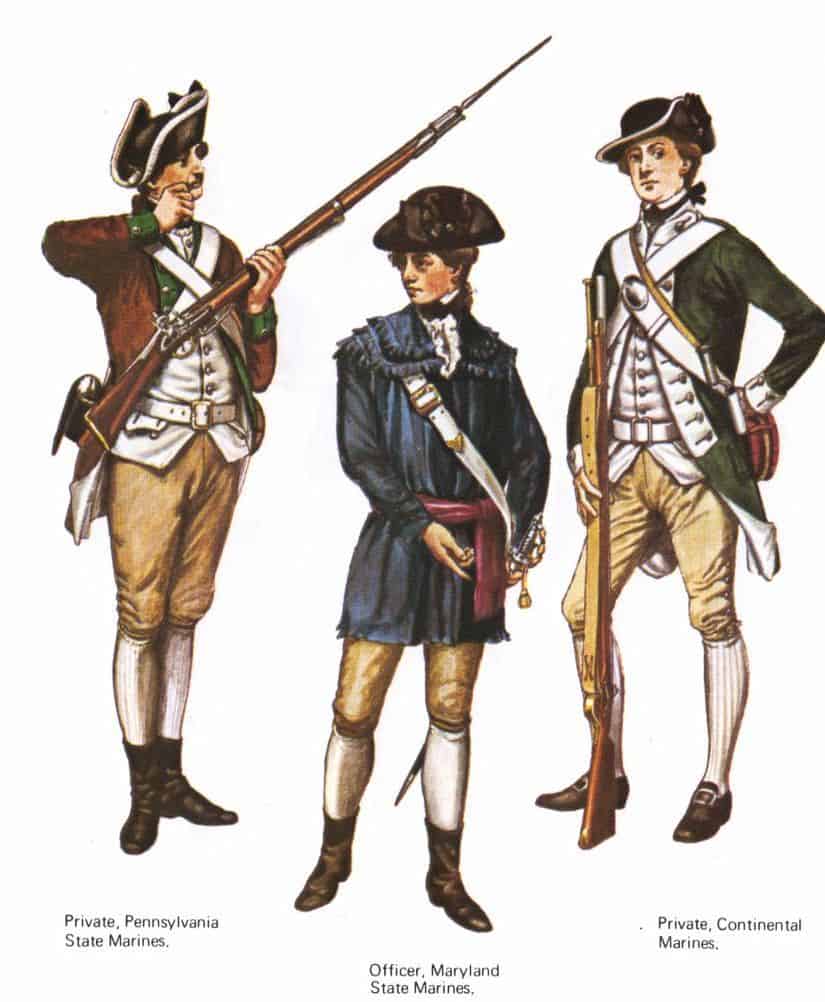 Revolutionary war marines. Weapons and Warfare
The Continental Marines
Marines were first raised in America during the War of Jenkins Ear (1739 – 1742), when the British Admiralty recruited a naval infantry regiment of 3000 men from the American colonies for a campaign against Spanish possessions in the Caribbean and South America. The result was a four battalion unit commonly known as “Gooch’s Marines”, after a Virginia governor named William Gooch, who raised and led the outfit. A dumping ground for criminals, debtors, and vagrants, Gooch’s Marines served credibly for the most part around the Caribbean. However, between tropical diseases and a disastrous attack against Cartagena, in today’s Colombia, the unit lost over 90% of its men by the time it was disbanded at war’s end in 1742.
When the American Revolution broke out, some American colonies’ militias formed their own marine contingents. Most prominent among those marine militia was Massachusetts’ Marblehead Regiment, formed in January of 1775 from seafaring men from the region around Marblehead, Massachusetts. Folded into the Continental Army in the summer of 1775, and reorganized as the 14th Continental Regiment early the following year, it served George Washington as an ad hoc marine unit, especially during his 1776 New York Campaign.
In the meantime, the Continental Congress decided to raise a marine unit, and on November 10th, 1775 a resolution drafted by future president John Adams was approved. It directed in relevant part: “That two Battalions of marines be raised, consisting of one Colonel, two Lieutenant Colonels, two Majors, and other officers as usual in other regiments; and that they consist of an equal number of privates with other battalions; that particular care be taken, that no persons be appointed to office, or enlisted into said Battalions, but such as are good seamen, or so acquainted with maritime affairs as to be able to serve to advantage by sea when required; that they be enlisted and commissioned to serve for and during the present war between Great Britain and the colonies, unless dismissed by order of Congress“.
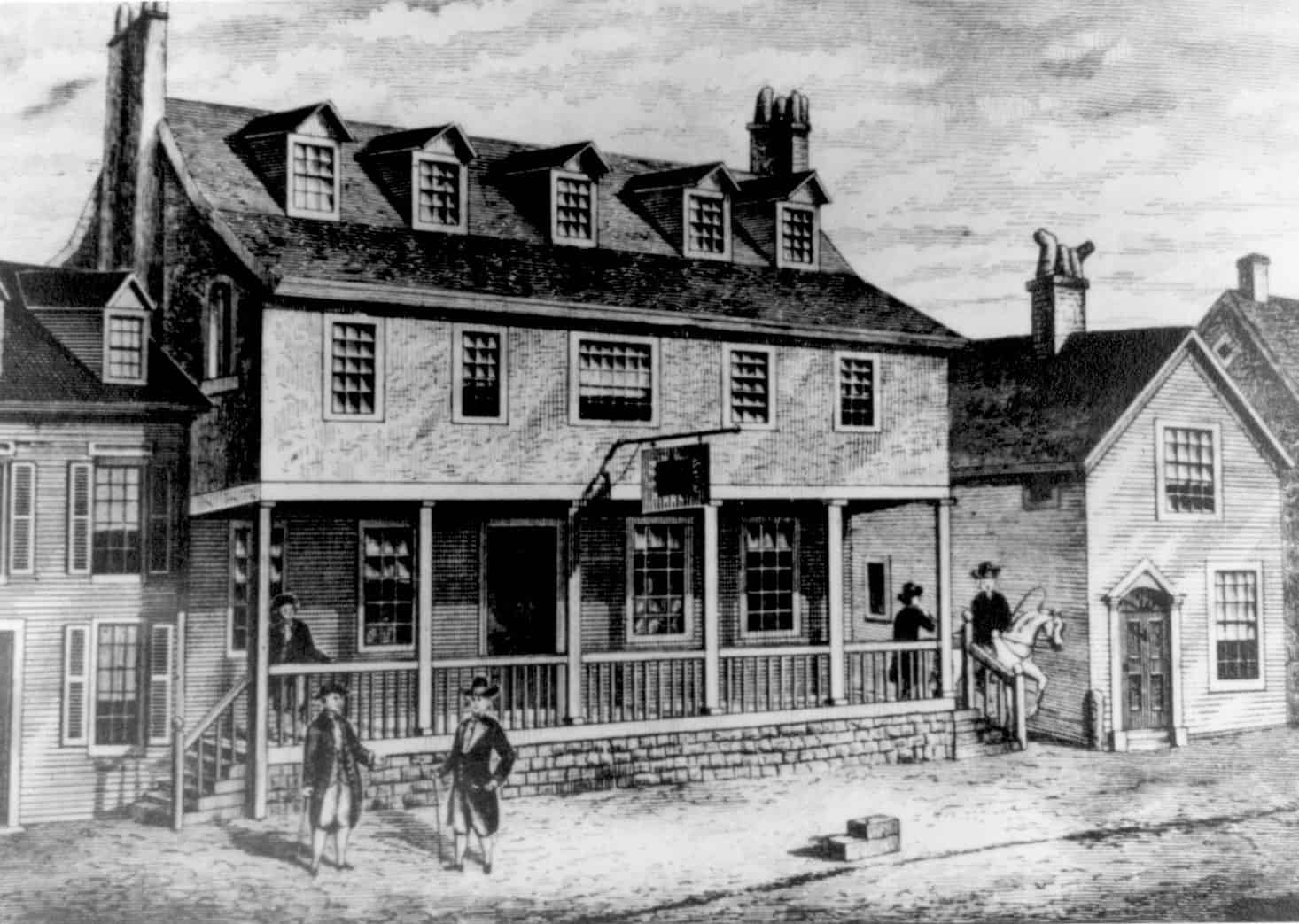 Tun Tavern in Philadelphia, birthplace of the United States Marine Corps during the Revolutionary War. Wikimedia
November 10th is celebrated to this day as the birthday of the United States Marine Corps. To implement the congressional directive, a Pennsylvania captain named Samuel Nicholas set up a recruiting headquarters in Tun Tavern, on Water Street in Philadelphia, which is considered the birthplace of the US Marines. Tun Tavern was a successful establishment with a reputation for serving fine beer, and Captain Nicholas appointed its owner, Robert Mullan, to serve as his chief Marine recruiter.
A good pitch and a good pitcher of beer go well together, and within weeks, enough Marines had been recruited to man the Continental Navy’s ships in the waters off Philadelphia. On January 4th, 1776, less than two months after the congressional directive that ordered the Continental Marines into being, Captain Nicholas and his naval infantry set sail. Two months later, Nicholas and his Continental Marines would have their baptism of fire at the Battle of Nassau, in the Bahamas.
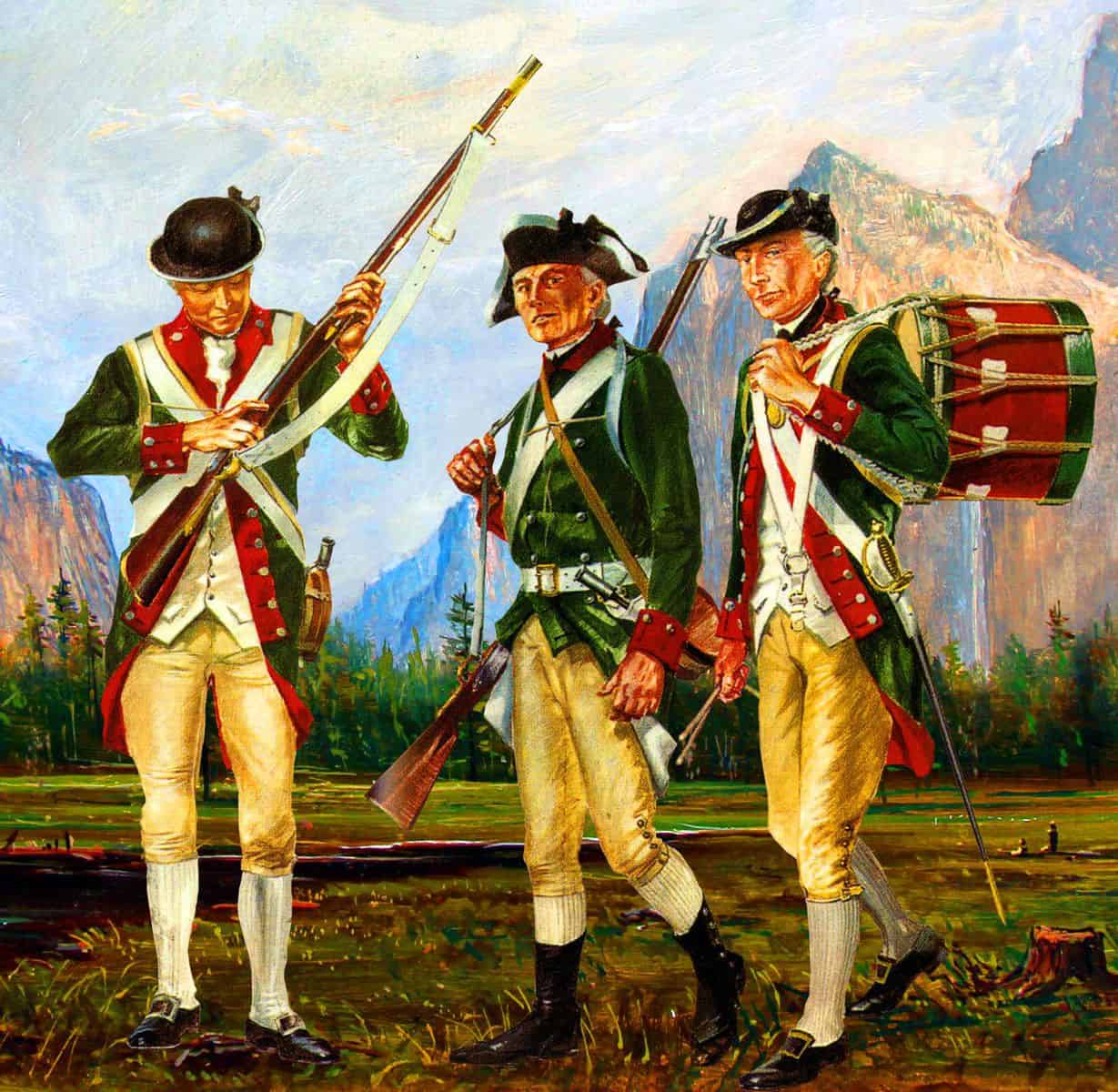 Continental Marines, circa 1777. Pintrest
The Marines’ First Action and Aftermath
The Continental Marines’ first combat operation came about because the Continental Army was hard pressed for gunpowder. Its recently appointed commander in chief, general George Washington, had asked Congress for 400 barrels of gunpowder, but his political masters responded by sending him fewer than 40 barrels – barely enough for 20 rounds per soldier. Despite Washington’s repeated remonstrations, pleas, and threats of impending disaster if his forces were not adequately supplied, no more gunpowder was forthcoming. So alternatives were sought, and it was decided that if Congress could not provide what was needed, perhaps the British would.
Virginia’s colonial governor, Lord Dunmore, had removed his colony’s stores of weapons and munitions – including gunpowder – to Nassau, New Providence Island, in the Bahamas, when the Revolutionary War erupted, to secure them against capture by the rebels. When word arrived that there were over 200 barrels of gunpowder stored in the Bahamas, Congress directed the commander of the recently established Continental Navy, Esek Hopkins, to raid the British stores and seize the desperately needed munitions. The ensuing naval operation and amphibious assault was to be the first significant engagement of the new Navy and Marines.
On February 17th, 1776, Esek Hopkins sailed from Delaware to the Bahamas with a small fleet of eight ships, accompanied by a contingent of Continental Marines under the command of captain Samuel Nicholas. Stormy weather forced two of Hopkins’ ships to turn back, but he sailed on with his remaining six vessels, finally reaching New Providence Island on March 1st. There, he promptly captured two British merchantmen off Nassau, replacing the two ship he had lost on the way there. Then, for reasons lost to history, Hopkins kept his ships anchored offshore for two days, before finally landing a force of about 200 Marines and 50 sailors on the morning of March 3rd.
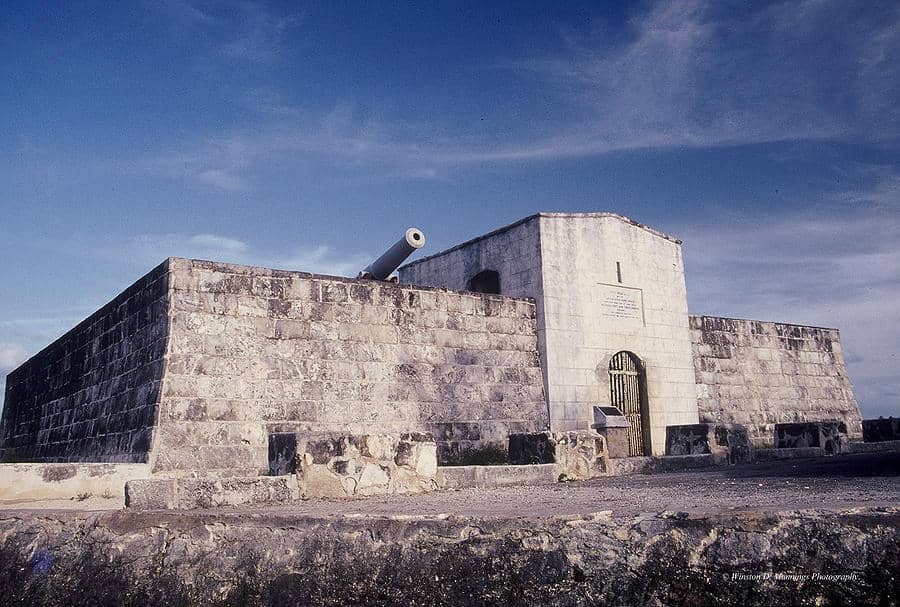 Fort Montagu in the Bahamas, the first fortification captured by an American marine amphibious landing. Fine Art America
By then, the defenders were aware that enemy vessels were operating in their waters, and when ships were spotted sailing in to Nassau, the alarm was raised. At the approach of the American forces, the outnumbered defenders evacuated Fort Montagu, one of two fortifications defending Nassau, and it was promptly occupied by captain Nicholas and his Continental Marines. Nicholas failed to continue on to and capture Nassau that day, however, and spent the night of the 3rd in Fort Montagu. That night, the British in Nassau loaded most of the gunpowder stored there – 162 barrels out 200 – aboard a ship, which managed to sneak out of the harbor and sail away to safety. The following morning, Nicholas and his men occupied Nassau, and seized the remaining 38 barrels of gunpowder, wrapping up the Continental Marines’ first major operation.
By war’s end, the Continental Marines had grown to over 2000 men. After America secured its independence in 1783, the Continental Navy was demobilized, and its Marines were disbanded. In subsequent years, however, tensions with European powers, particularly France, played out on the high seas, and America’s inability to protect its shipping or retaliate against aggression led Congress to formally reestablish the US Navy in May of 1798. Two months later, on July 11th, 1798, president John Adams signed into law a bill establishing the United States Marine Corps as a standing military force within the Department of the Navy.
_________________
Where Did We Find This Stuff? Some Sources and Further Reading
History – Birth of the US Marine Corps
Military – The Origins of the Marine Corps
Time Magazine, November 10th, 2015 – How the US Marine Corps Was Founded Twice
Varsity Tutors – The Continental Marines: The Birth of the Leathernecks
Wikipedia – History of the United States Marine Corps
Marine Corps University – Brief History of the United States Marine Corps
https://historycollection.com/the-origins-and-birth-of-the-united-states-marine-corps/#the-marines-first-action-and-aftermath |
|
|
|
جواب |
رسائل 8 من 20 في الفقرة |
|
|
|
|
جواب |
رسائل 9 من 20 في الفقرة |
|
|
|
|
جواب |
رسائل 10 من 20 في الفقرة |
|
In 1898, a Minnesota farmer clearing trees from his field uproots a large stone covered with mysterious runes. See more in this special, ...
|
|
|
|
جواب |
رسائل 11 من 20 في الفقرة |
|
https://www.lanacion.com.ar/lifestyle/isla-oak-la-leyenda-del-tesoro-que-ya-se-cobro-6-victimas-y-cientos-de-frustraciones-nid18062021/ |
|
|
|
جواب |
رسائل 12 من 20 في الفقرة |
|
 https://www.oakislandlegend.com/the-old-gold-salvage-and-wrecking-company.html https://www.oakislandlegend.com/the-old-gold-salvage-and-wrecking-company.html |
|
|
|
|
جواب |
رسائل 13 من 20 في الفقرة |
|
https://www.oakislandlegend.com/the-old-gold-salvage-and-wrecking-company.html |
|
|
|
جواب |
رسائل 14 من 20 في الفقرة |
|
Canada’s Holy Grail: Lord Stanley’s Political Motivation to Donate the Stanley Cup
by Jordan B. Goldstein
University of Toronto Press
341 pages, $32.95
For a hockey-crazy country, it makes sense that hockey’s ultimate award — the Stanley Cup — holds a prominent place in the Canadian psyche. The cup is a Canadian icon, but how did a silver trophy donated by a Governor General in 1892 become a meaningful part of our identity?
According to Jordan B. Goldstein, author of Canada’s Holy Grail: Lord Stanley’s Political Motivation to Donate the Stanley Cup, it was by design. When Lord Frederick Arthur Stanley, Canada’s sixth Governor General, donated the Dominion Hockey Challenge Cup (later known as the Stanley Cup) in March 1892, he set out to foster Canadian unity and nationalism.
“Donating the cup was an attempt on [Stanley’s] part to build a nation through sport. Given that as governor general, he was head of the Canadian state, his act was political. Setting aside that he had a personal interest in ice hockey and desired to promote it, the creation of the Stanley Cup had political implications,” writes Goldstein, a professor in the Department of Kinesiology at Wilfrid Laurier University.
When Stanley served as Governor General from 1888 to 1893, Canada faced two potential outcomes: grow as an independent nation and remain close to Great Britain, or join the United States. He also recognized the division between French and English Canada as well as the difficult and fractious nature of Canadian politics at the time.
While Stanley wanted to help Canada mature, he understood that his role required impartiality, so he approached the task of building unity — an inherently political act — via his mandate of celebrating excellence.
Stanley chose to celebrate hockey. He envisioned a national championship and provided it with an award. “A physical symbol of national ice hockey supremacy would help support the Canadian state by inducing competition across a national system of ice hockey participants and thereby fostering a shared national sentiment,” writes Goldstein.

You could win a free book!
Sign up for any of our newsletters and be eligible to win one of many book prizes available.
In exploring Stanley’s motivation, Goldstein looks at Stanley’s life as it intersected with Canadian history, identity, philosophy, politics, and, of course, sports. He also explains why Stanley thought only hockey could be Canada’s national sport, and not baseball or lacrosse, both of which were popular at the time. Baseball belonged to the United States, while lacrosse — Canada’s national game at the time of Confederation — had lost its appeal as its supporters chose to remain true to the British Amateur Code rather than seeing lacrosse grow as a professional sport.
In short, to understand why Stanley donated the cup, we must also understand his time as Governor General and why, during a time of “national pessimism, especially in terms of national identity and culture,” Canada needed a strong symbol.
Even though Goldstein shares Stanley’s love of hockey, Canada’s Holy Grail is not a light read about the Governor General and his prize. Instead, it involves meticulous analysis that relies on primary and secondary sources. While historical analysis may not be everyone’s silver cup, Goldstein’s research is fascinating, and his book allows readers to understand a unique part of Canada’s history and identity. It also tells us how a trophy donated by a Governor General became an enduring symbol of the country.
As a result, Canada’s Holy Grail is well suited for anyone who loves hockey, Canadian history, and Canadian political thought — and who is not afraid of some intellectual work. In the end, we owe Stanley great thanks for creating a Canadian icon and, at the same time, helping to create a more unified Canada.
https://www.canadashistory.ca/explore/books/canada-s-holy-grail |
|
|
|
جواب |
رسائل 15 من 20 في الفقرة |
|
|
|
|
جواب |
رسائل 16 من 20 في الفقرة |
|
|
|
|
جواب |
رسائل 17 من 20 في الفقرة |
|
Governor General David Johnston (right) with actor Michael J.Fox at Rideau Hall on May 27, 2011 during an Order of Canada ceremony.
PATRICK DOYLE / THE CANADIAN PRESS
OTTAWA—Actor Michael J. Fox is now an officer of the Order of Canada.
The Edmonton-born actor and activist is among 43 people who received their medals from Gov. Gen. David Johnston at a Rideau Hall ceremony.
Others include rock legend Robbie Robertson, hockey commentator Howie Meeker, Acadian filmmaker Phil Comeau, former cabinet minister Anne McLellan and Trudeau biographer Stephen Clarkson.
Fox was honoured for his efforts on behalf of those suffering from Parkinson’s disease, as well as his television and film work.
Fox, diagnosed with Parkinson’s two decades ago, called the award a great honour.
He chuckled that he felt like an imposter when he glanced around at his fellow inductees.
“I don’t begin for a second to put myself in the league of any of these people,” he said. “When I listen to what they’ve done, that’s Canadian to me. It’s a seriousness and a sense of humour, it’s a lot of contradictions.”
He said Canada always makes him think “of vast spaces and tight communities.”
“We think of ourselves huddled against the elements and helping each other. It’s very moving to be part of it.”
https://www.thestar.com/entertainment/michael-j-fox-receives-order-of-canada/article_8f612aa5-9d87-5133-9984-8c2b1b3eaa4f.html |
|
|
|
جواب |
رسائل 18 من 20 في الفقرة |
|
10 momentos clave en este video
|
|
|
|
جواب |
رسائل 19 من 20 في الفقرة |
|
It gets even more intriguing when Pan Am 103 is added to the correlation. First, it needs to be mentioned that the same Quatrain VI-97 had been very closely associated to another notorious plane crash - TWA 800 (as shown in 'Babylon Matrix'). And again, somehow, another major and equally notorious place crash, Pan Am 103, comes to relate to the same quatrain. Besides the timing (i.e. coinciding with the bombing of Novi Sad), an interesting correlation can be made with VI-97's fourth line, "When they want to have proof of the Normans", as one of the Scottish prosecutors for the trial is named 'Norman' (McFadyen) as mentioned in the news article. Obviously, the "proof of (the) Norman(s)" is to be a key part of the trial, thus nicely fitting the line.
Next, the involvement of Scotland in the Pan Am 103 incident turns out to be significant through Scotland's strong historical connection to the Masonic/Templar tradition from which the stories of the Ark/Grail cannot be separated. What fills the gaps between the issues (Pam Am 103/Scotland, Ark/Grail, VI-97, etc.) is yet another plane crash, the crash of Swissair 111 (Sept. 2, '98) off Nova Scotia, Canada, which was en route from NYC to Geneva, Switzerland. It is one of the most recent major airplane crashes. It is rather congruent that a recent major plane crash, Swissair 111, is to be linked, as we will see, with both TWA 800 and Pan Am 103, as both of those two airplane incidents made the headlines recently (the story of TWA 800's crash itself, and the story about the handover of the suspects of Pan Am 103) and both are hypothesized to be connected to Quatrain VI-97.
The link between TWA 800 and Swissair 111 is insinuated by the fact that both crashed mysteriously soon after taking off from NYC. Those incidents were only about 1 year apart (July '97 and Sept. '98). The connection between Swissair 111 and Pan Am 103 is first suggested in the name 'Nova Scotia' (where the Swissair 111 crash occurred) which means 'New Scotland' (Pan Am 103 exploded over Scotland). Notice that the "New" part can relate to VI-97's "new city" and it also happens that Nova Scotia is nicely bisected by the "45 degrees" N latitude, and Nova Scotia is historically closely connected with France (=> "Normans"). Furthermore, Swissair 111's destination Switzerland is roughly at "45 degrees" N., and the name Switzerland is derived from a word that means 'to burn' - as in "45 degrees the sky will burn" (!) (it's, therefore, interesting that the capital of Switzerland is called 'Bern'), strengthening the connection between Swissair 111 and VI-97.
And here are some Scotland-Nova Scotia connections that will shift the focus to the new 'associative matrix' of Ark/Grail. It happens that Nova Scotia, like Scotland, is also involved in the Templar tradition and the 'Holy Grail'. Nova Scotia, it turns out, is exactly where the 'Holy Grail' (whatever it may represent) is theorized by some scholars to have been taken by the Knights Templar. In support of this theory, the region of Nova Scotia and the land around it was called 'Acadia' by the French which closely resembles 'Arcadia' which is a term that is very closely associated with the Grail tradition.
The involvement of Switzerland is also very significant as it is a country theorized by some to be founded by the Templars - the country's flag (white cross on red background - the reverse of the Templar symbol of 'red/rose cross') and its famous banking business (the Templars essentially founded the banking system we use today) strongly suggests this, for example. It is also interesting to note that Switzerland is located largely on the Alps which forms a big 'arc' (that separates Italy, France and Switzerland) potentially relatable to the 'Ark' theme. Additionally, the word 'arktos', in Greek, resembling 'ark', refers to the constellation Ursa Major known to Egyptians as 'the thigh' - which can be correlated with the Alps/Switzerland because as you probably know Italy is shaped like a leg with a high-heel shoe and if you consider the size of the foot/shoe, anatomically the land of Italy would correspond to the calf and the Alps/Switzerland region would correspond to the thigh!
For subtler links, we can add that Paris, the destination of TWA 800, has as its landmark the 'Arc de Triomphe' (which was discussed extensively in my long piece, 'The Elysian Fields', so this connection is not as arbitrary as some of you might think), and the mythological character 'Paris' happens to be closely associated with 'torch', thus relating to the fire/flame/burn theme derived from VI-97. It should also be noted that the Statue of Liberty standing beside Long Island/'Fire' Island of NYC (with which TWA 800 and Swissair 111 are connected) which holds the 'torch' of freedom was given to U.S. by France, and there is a smaller replica of the statue in Paris. (For more detailed exposition on the link between the Statue of Liberty and Quatrain VI-97, see 'Babylon Matrix') Additionally, the flight number of the Swissair plane, '111', also seems to bear a subtle esoteric symbolism, as the Sumerian version of (Noah's) 'Ark' (which can be linked with the Ark of the Covenant in some ways) "was a cube - a modest one, measuring 60x60x60 fathoms, which represents the unit in the sexagesimal system where 60 is written as 1" (Hamlet's Mill, p219). So, the ark could also be seen as 1x1x1 or '111', the number of the plane.
https://www.goroadachi.com/etemenanki/1999-sirius.htm |
|
|
|
جواب |
رسائل 20 من 20 في الفقرة |
|
The lost history of the Freemasons
Amanda Ruggeri
Features correspondent
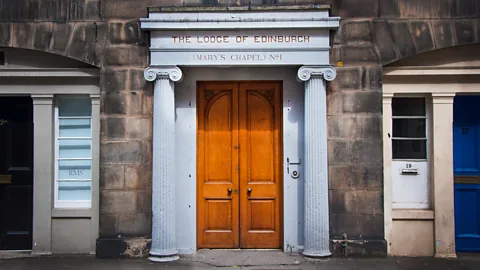 Amanda Ruggeri Amanda Ruggeri
Mary’s Chapel may only be open to fellow Freemasons, but its location is anything but a secret (Credit: Amanda Ruggeri)
Conspiracy theories abound about the Freemasons. But Scotland’s true Masonic history, while forgotten by many for centuries, remains hidden in plain sight.
With its cobblestone paving and Georgian façades, tranquil Hill Street is a haven in Edinburgh’s busy New Town. Compared to the Scottish capital’s looming castle or eerie closes, it doesn’t seem like a street with a secret.
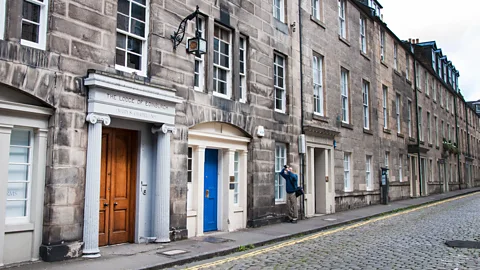 Amanda Ruggeri Amanda Ruggeri
Tranquil and historic, Edinburgh’s Hill Street attracts few tourists (Credit: Amanda Ruggeri)
Walk slowly, though, and you might notice something odd. Written in gold gilt above a door framed by two baby-blue columns are the words, “The Lodge of Edinburgh (Mary’s Chapel) No 1”. Further up the wall, carved into the sandstone, is a six-pointed star detailed with what seem – at least to non-initiates – like strange symbols and numbers.
Located at number 19 Hill Street, Mary’s Chapel isn’t a place of worship. It’s a Masonic lodge. And, with its records dating back to 1599, it’s the oldest proven Masonic lodge still in existence anywhere in the world.
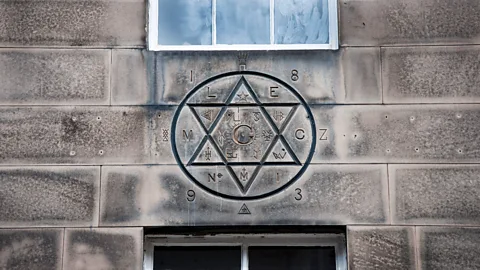 Amanda Ruggeri Amanda Ruggeri
At 19 Hill Street, look up to see this six-pointed star, a Masonic symbol (Credit: Amanda Ruggeri)
That might come as a surprise to some people. Ask most enthusiasts when modern Freemasonry began, and they’d point to a much later date: 1717, the year of the foundation of what would become known as the Grand Lodge of England. But in many ways, Freemasonry as we know it today is as Scottish as haggis or Harris tweed.
From the Middle Ages, associations of stonemasons existed in both England and Scotland. It was in Scotland, though, that the first evidence appears of associations – or lodges – being regularly used. By the late 1500s, there were at least 13 established lodges across Scotland, from Edinburgh to Perth. But it wasn’t until the turn of the 16th Century that those medieval guilds gained an institutional structure – the point which many consider to be the birth of modern Freemasonry.
Take, for example, the earliest meeting records, usually considered to be the best evidence of a lodge having any real organisation. The oldest minutes in the world, which date to January 1599, is from Lodge Aitchison’s Haven in East Lothian, Scotland, which closed in 1852. Just six months later, in July 1599, the lodge of Mary’s Chapel in Edinburgh started to keep minutes, too. As far as we can tell, there are no administrative records from England dating from this time.
“This is, really, when things begin,” said Robert Cooper, curator of the Grand Lodge of Scotland and author of the book Cracking the Freemason’s Code. “[Lodges] were a fixed feature of the country. And what is more, we now know it was a national network. So Edinburgh began it, if you like.”
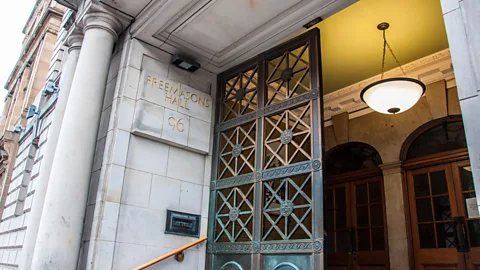 Amanda Ruggeri Amanda Ruggeri
The Grand Lodge of Scotland, also known as Freemasons Hall, stands in the heart of Edinburgh’s New Town (Credit: Amanda Ruggeri)
I met Cooper in his office: a wood-panelled, book-stuffed room in the Grand Lodge of Scotland at 96 George Street, Edinburgh – just around the corner from Mary’s Chapel. Here and there were cardboard boxes, the kind you’d use for a move, each heaped full with dusty books and records. Since its founding in 1736, this lodge has received the records and minutes of every other official Scottish Masonic lodge in existence. It is also meant to have received every record of membership, possibly upwards of four million names in total.
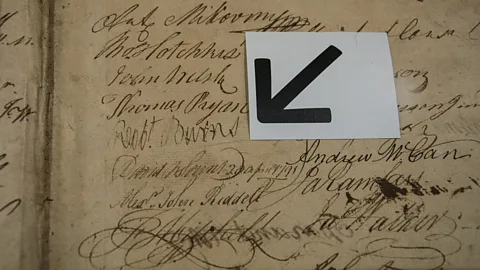 Amanda Ruggeri Amanda Ruggeri
One of the items on display at the Grand Lodge of Scotland’s museum is its membership record with the signature of famed Freemason Robert Burns (Credit: Amanda Ruggeri)
That makes the sheer number of documents to wade through daunting. But it’s also fruitful, like when the Grand Lodge got wind of the Aitchison’s Haven minutes, which were going for auction in London in the late 1970s. Another came more recently when Cooper found the 115-year-old membership roll book of a Scottish Masonic lodge in Nagasaki, Japan.
“There’s an old saying that wherever Scots went in numbers, the first thing they did was build a kirk [church], then they would build a bank, then they would build a pub. And the fourth thing was always a lodge,” Cooper said, chuckling.
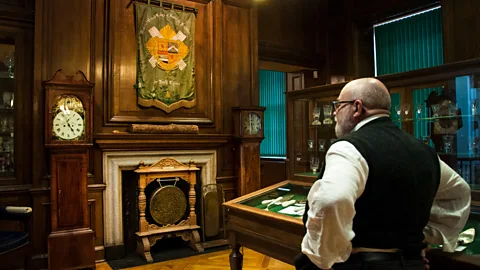 Amanda Ruggeri Amanda Ruggeri
The curator of the Grand Lodge of Scotland, Robert Cooper, looks over the lodge’s museum (Credit: Amanda Ruggeri)
That internationalism was on full display in the Grand Lodge of Scotland’s museum, which is open to the public. It was full of flotsam and jetsam from around the world: a green pennant embroidered with the “District Grand Lodge of Scottish Freemasonry in North China”; some 30 Masonic “jewels” – or, to non-Masons, medals – from Czechoslovakia alone.
Of course, conspiracy theorists find that kind of reach foreboding. Some say Freemasonry is a cult with links to the Illuminati. Others believe it to be a global network that’s had a secret hand in everything from the design of the US dollar bill to the French Revolution. Like most other historians, Cooper shakes his head at this.
“If we’re a secret society, how do you know about us?” he asked. “This is a public building; we’ve got a website, a Facebook page, Twitter. We even advertise things in the press. But we’re still a ‘secret society’ running the world! A real secret society is the Mafia, the Chinese triads. They are real secret societies. They don’t have a public library. They don’t have a museum you can wander into.”
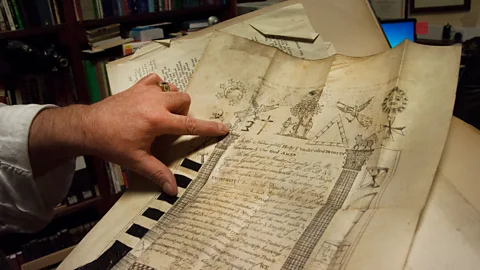 Amanda Ruggeri Amanda Ruggeri
Cooper points to the Masonic symbols on one of the many historic documents in the lodge’s archive (Credit: Amanda Ruggeri)
Some of the mythology about Freemasonry stems from the mystery of its early origins. One fantastical theory goes back to the Knights Templar; after being crushed by King Philip of France in 1307, the story goes, some fled to Argyll in western Scotland, and remade themselves as a new organisation called the Freemasons. (Find out more in our recent story about the Knights Templar).
Others – including Freemasons themselves – trace their lineage back to none other than King Solomon, whose temple, it’s said, was built with a secret knowledge that was transferred from one generation of stonemason to the next.
A more likely story is that Freemasonry’s early origins stem from medieval associations of tradesmen, similar to guilds. “All of these organisations were based on trades,” said Cooper. “At one time, it would have been, ‘Oh, you’re a Freemason – I’m a Free Gardener, he’s a Free Carpenter, he’s a Free Potter’.”
At one time, it would have been, ‘Oh, you’re a Freemason – I’m a Free Gardener, he’s a Free Carpenter, he’s a Free Potter’ – Robert Cooper
For all of the tradesmen, having some sort of organisation was a way not only to make contacts, but also to pass on tricks of the trade – and to keep outsiders out.
But there was a significant difference between the tradesmen. Those who fished or gardened, for example, would usually stay put, working in the same community day in, day out.
Not so with stonemasons. Particularly with the rush to build more and more massive, intricate churches throughout Britain in the Middle Ages, they would be called to specific – often huge – projects, often far from home. They might labour there for months, even years. Thrown into that kind of situation, where you depended on strangers to have the same skills and to get along, how could you be sure everyone knew the trade and could be trusted? By forming an organisation. How could you prove that you were a member of that organisation when you turned up? By creating a code known by insiders only – like a handshake.
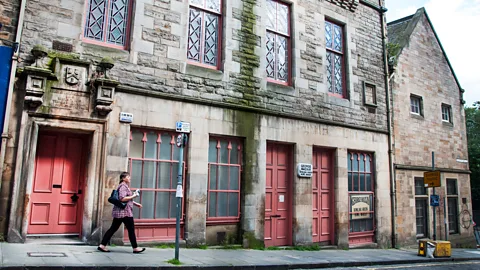 Amanda Ruggeri Amanda Ruggeri
Edinburgh's Lodge of Journeyman Masons No. 8 was founded in 1578; this lodge was built for it on Blackfriars Street in 1870 (Credit: Amanda Ruggeri)
Even if lodges existed earlier, though, the effort to organise the Freemason movement dates back to the late 1500s. A man named William Schaw was the Master of Works for King James VI of Scotland (later also James I of England), which meant he oversaw the construction and maintenance of the monarch’s castles, palaces and other properties. In other words, he oversaw Britain’s stonemasons. And, while they already had traditions, Schaw decided that they needed a more formalised structure – one with by-laws covering everything from how apprenticeships worked to the promise that they would “live charitably together as becomes sworn brethren”.
In 1598, he sent these statutes out to every Scottish lodge in existence. One of his rules? A notary be hired as each lodge’s clerk. Shortly after, lodges began to keep their first minutes.
“It’s because of William Schaw’s influence that things start to spread across the whole country. We can see connections between lodges in different parts of Scotland – talking to each other, communicating in different ways, travelling from one place to another,” Cooper said.
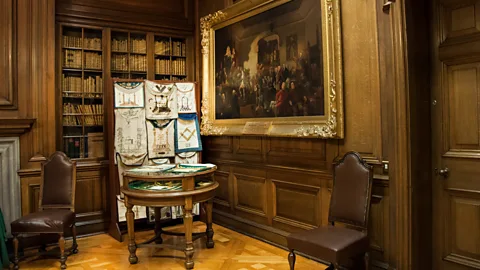 Amanda Ruggeri Amanda Ruggeri
This oil painting at the Grand Lodge of Scotland shows Robert Burns’ inauguration at Lodge Canongate Kilwinning No. 2, which was founded in 1677 (Credit: Amanda Ruggeri)
Scotland’s influence was soon overshadowed. With the founding of England’s Grand Lodge, the English edged out in front of the movement’s development. And in the centuries since, Freemasonry’s Scottish origins have been largely forgotten.
“The fact that England can claim the first move towards national organisation through grand lodges, and that this was copied subsequently by Ireland (c 1725) and Scotland (1736), has led to many English Masonic historians simply taking it for granted that Freemasonry originated in England, which it then gave to the rest of the world,” writes David Stevenson in his book The Origins of Freemasonry.
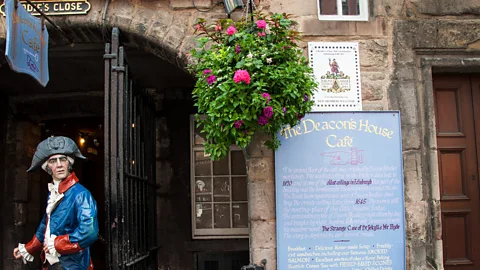 Amanda Ruggeri Amanda Ruggeri
Hidden in plain sight on Brodie’s Close off of Edinburgh’s Royal Mile, the Celtic Lodge of Edinburgh and Leith No. 291 was founded in 1821 (Credit: Amanda Ruggeri)
Cooper agrees. “It is in some ways a bit bizarre when you think of the fact that we have written records, and therefore membership details, and all the plethora of stuff that goes with that, for almost 420 years of Scottish history,” he said. “For that to remain untouched as a source – a primary source – of history is really rather odd.”
One way in which most people associate Freemasonry and Scotland, meanwhile, is Rosslyn Chapel, the medieval church resplendent with carvings and sculptures that, in the wake of Dan Brown’s Da Vinci Code, many guides have explained as Masonic. But the building’s links to Masonry are tenuous. Even a chapel handbook published in 1774 makes no mention of any Masonic connections.
 Amanda Ruggeri Amanda Ruggeri
Mary’s Chapel may only be open to fellow Freemasons, but its location is anything but a secret (Credit: Amanda Ruggeri)
Scotland’s true Masonic history, it turns out, is more hidden than the church that Dan Brown made famous. It’s just hidden in plain sight: in the Grand Lodge and museum that opens its doors to visitors; in the archivist eager for more people to look at the organisation’s historical records; and in the lodges themselves, tucked into corners and alleyways throughout Edinburgh and Scotland’s other cities.
Their doors may often be closed to non-members, but their addresses, and existence, are anything but secret.
This story is a part of BBC Britain – a series focused on exploring this extraordinary island, one story at a time. Readers outside of the UK can see every BBC Britain story by heading to the Britain homepage; you also can see our latest stories by following us on Facebook and .
If you liked this story, sign up for the weekly bbc.com features newsletter, called “If You Only Read 6 Things This Week”. A handpicked selection of stories from BBC Future, Earth, Culture, Capital, Travel and Autos, delivered to your inbox every Friday.
https://www.bbc.com/travel/article/20161209-secret-history-of-the-freemasons-in-scotland |
|
|
 أول أول
 سابق
6 a 20 de 20
لاحق سابق
6 a 20 de 20
لاحق
 آخر
آخر

|
|
| |
|
|
©2025 - Gabitos - كل الحقوق محفوظة | |
|
|
 A drawing of one of the Templar Knights. Borstnar.
A drawing of one of the Templar Knights. Borstnar.
 A drawing of a group of Templars. Ancient Origins.
A drawing of a group of Templars. Ancient Origins.


















 A representation of a Knight Templar (Ten Duinen Abbey museum, 2010). Photo by JoJan CC BY 3.0/The Vintage News.
A representation of a Knight Templar (Ten Duinen Abbey museum, 2010). Photo by JoJan CC BY 3.0/The Vintage News.
 Map of Oak Island, Nova Scotia. Photo by Oaktree CC BY-SA 4.0/ The Vintage News.
Map of Oak Island, Nova Scotia. Photo by Oaktree CC BY-SA 4.0/ The Vintage News.
 A drawing of a Templar Knight on horseback. Anonymous Radio Show.
A drawing of a Templar Knight on horseback. Anonymous Radio Show.
 Island and Wharf, Oak Island, Nova Scotia, Canada, August 1931. The Vintage News.
Island and Wharf, Oak Island, Nova Scotia, Canada, August 1931. The Vintage News.
 A photograph of Franklin D. Roosevelt and others at Oak Island in Nova Scotia. The Vintage News.
A photograph of Franklin D. Roosevelt and others at Oak Island in Nova Scotia. The Vintage News.
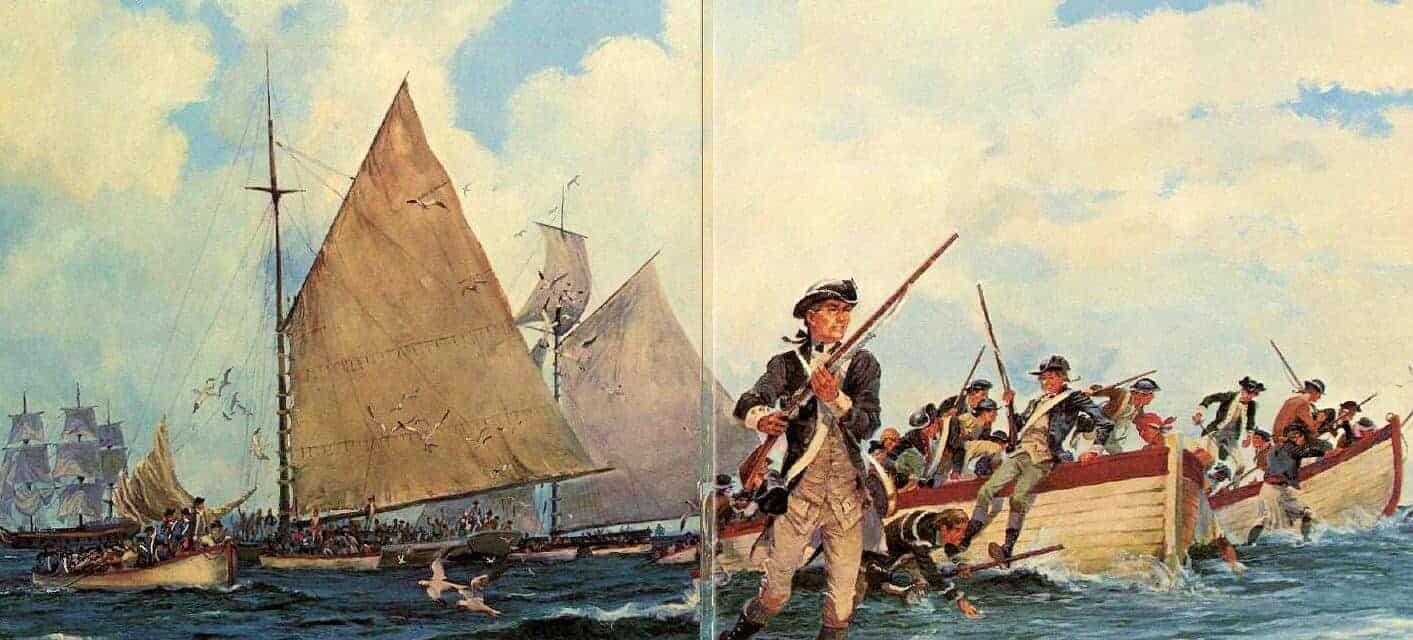
 Ancient Phoenician marine. Pintrest
Ancient Phoenician marine. Pintrest
 British Royal Marines accompanying captain Cook as he talks with South Sea islanders. Pintrest
British Royal Marines accompanying captain Cook as he talks with South Sea islanders. Pintrest
 Revolutionary war marines. Weapons and Warfare
Revolutionary war marines. Weapons and Warfare
 Tun Tavern in Philadelphia, birthplace of the United States Marine Corps during the Revolutionary War. Wikimedia
Tun Tavern in Philadelphia, birthplace of the United States Marine Corps during the Revolutionary War. Wikimedia
 Continental Marines, circa 1777. Pintrest
Continental Marines, circa 1777. Pintrest
 Fort Montagu in the Bahamas, the first fortification captured by an American marine amphibious landing. Fine Art America
Fort Montagu in the Bahamas, the first fortification captured by an American marine amphibious landing. Fine Art America
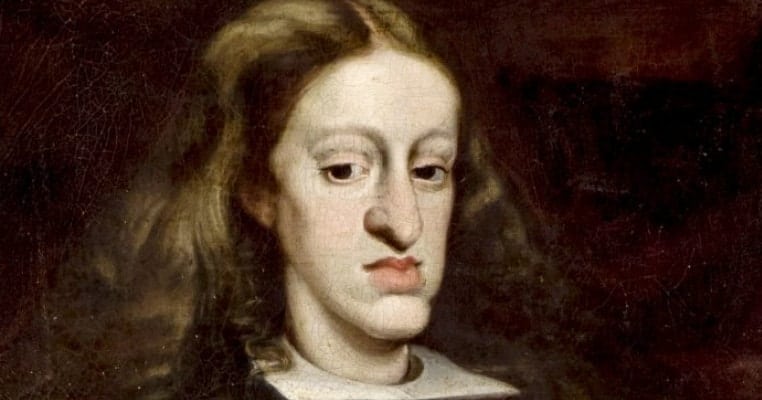




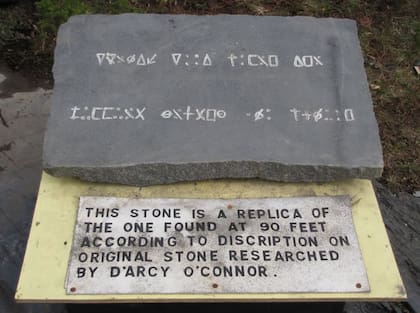
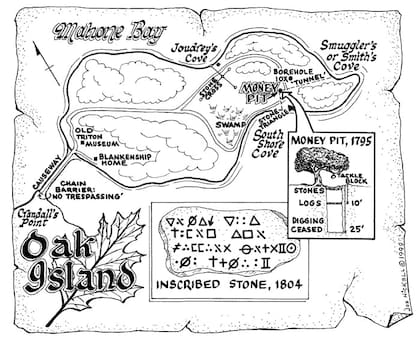
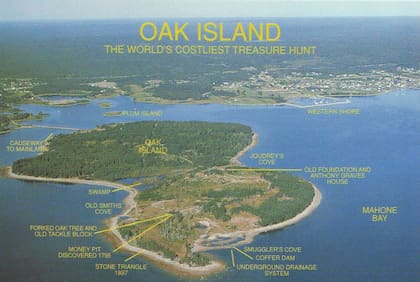
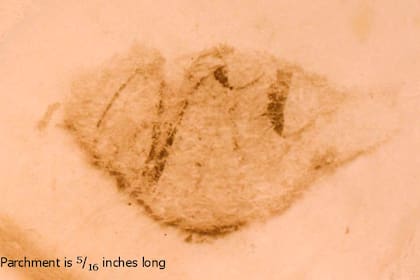
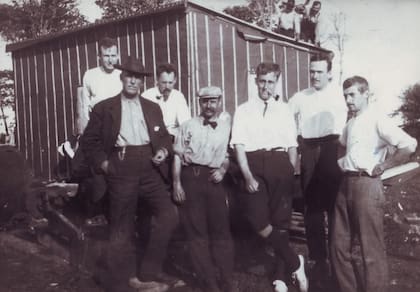
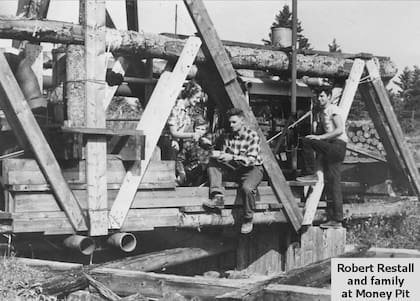
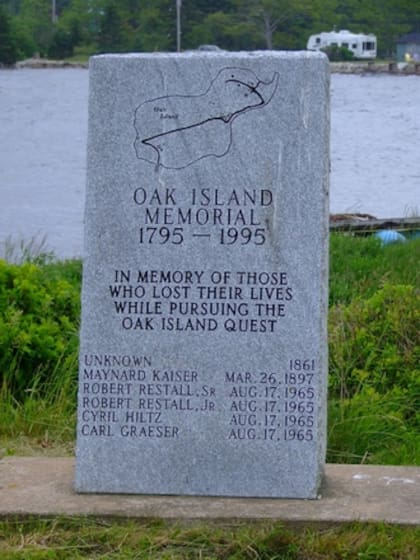
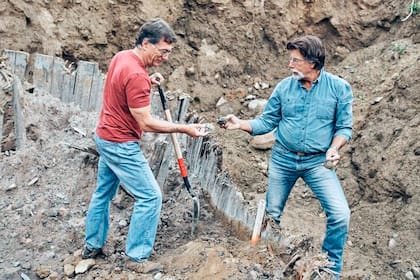
 https://www.oakislandlegend.com/the-old-gold-salvage-and-wrecking-company.html
https://www.oakislandlegend.com/the-old-gold-salvage-and-wrecking-company.html



























